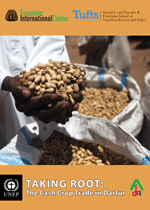This study explores the impact of a decade of conflict in Darfur on the trade in some of Darfur’s major cash crops. How has the cash crop trade adapted, and to what extent, if at all, has it recovered? It also reviews the federal policy context for trading cash crops. From this analysis, which identifies some of the major constraints faced by traders and agro-processors as well as producers, the study sets out ways in which the cash crop trade can be supported to better sustain livelihoods in Darfur, and to support the eventual recovery of Darfur’s economy. This is now especially relevant given the renewed focus on the agricultural sector in Sudan, post-secession. The study covers groundnuts, Darfur’s most important cash crop, as well as sesame, gum arabic, tombac (chewing tobacco), and oranges.
Taking Root: The Cash Crop Trade in Darfur

December 2013
ASSOCIATED PROJECT
SUBJECTS
PUBLICATION TYPE
LOCATION
RELATED PUBLICATIONS
This desk study explores how state-owned policies and programs in pastoral areas of the Sudano-Sahel and the Greater Horn of Africa meet pastoralists’ needs and priorities.
•
October 2024
This report outlines an anticipatory insurance product designed to support farmers in the drought-prone regions of Malawi and Zambia.
•
August 2024
The time pressure involved in designing and implementing anticipatory action can discourage the localization of decision-making. Learn more from a cartoon-infused summary of insights.
•
July 2024
Early Warning Systems can reduce deaths and damages caused by extreme weather events, if investors address gaps in communication and planning. Learn more from a cartoon-infused summary of insights.
•
July 2024
This synthesis report reflects upon Phase 1 findings on humanitarian action in pastoral drylands of the Greater Horn and Sudano-Sahel.
•
June 2024
This desk study examines common perceptions of pastoralism among humanitarians and barriers to international humanitarian systems meeting pastoralists’ needs.
•
June 2024






